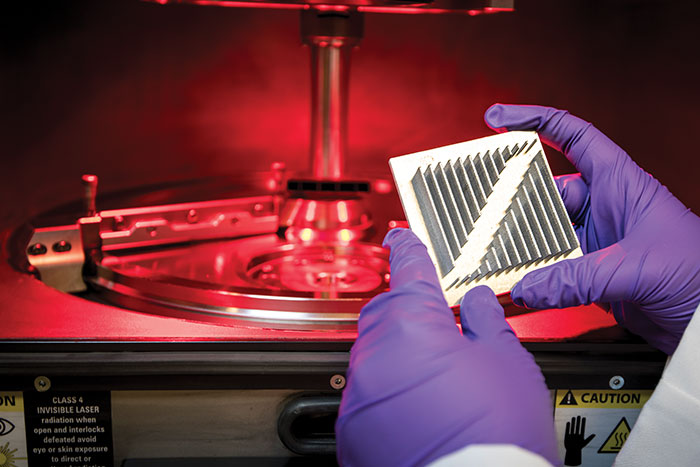The first development occurred in 2016, when General Electric Aviation used metal additive manufacturing to fabricate high-performance fuel nozzles, made of nickel-based superalloys, for a new line of turbofan aircraft engines. The technology enabled GE to fabricate a part with intricate internal geometries, including embedded cooling channels.
“It could not have been made by conventional methods,” said Paul, a professor of manufacturing engineering at Oregon State University. MAM also obviated the need for a supply chain involving a few dozen components from a couple dozen suppliers. “They placed the entire supply chain in a box, reducing markups while bringing control over a vital part of their engine in house,” Paul added. “Now they’re investing billions of dollars in MAM across multiple divisions, and it’s giving them a huge competitive advantage.”
By fall 2018, GE had printed more than 30,000 fuel nozzles, a solid entry into the growing MAM market — which analyst firm Transparency Market Research predicts will reach $10 billion by 2027.
The second development, also in 2016, was the arrival of Somayeh Pasebani, assistant professor of advanced manufacturing.
“During her interview, Somayeh talked about how MAM opens a door to developing new high-temperature alloys, and the idea just hit me on the head — the voxel-level control of material properties,” Paul said. (Think of a voxel as a solid, 3D pixel.) “I left that presentation thinking we needed to get funding to support this new avenue of research.” Voxel-level control with metals is so new, according to Paul and Pasebani, that Oregon State is the only place in the world doing it.
Together with teams across the College of Engineering, Paul and Pasebani have secured more than $6.3 million from the National Science Foundation and other federal, state, and private sources to develop a new generation of MAM technology. With the infusion of money, they partnered with staff at Oregon State’s Advanced Technology and Manufacturing Institute (ATAMI) to launch the Metal Additive Manufacturing Laboratory in 2016.
In powder bed fusion and directed energy deposition, two common MAM techniques, a laser melts and fuses layer upon layer of metal powder (or wire) into shapes prescribed by CAD files. Each layer varies in thickness from about 20 to more than 100 micrometers.
MAM offers some important advantages: forming alloys into complex shapes that would be difficult — if not impossible — to make with standard manufacturing practices; reducing multicomponent assemblies into a single build (like the GE nozzles); “lightweighting” parts through topology optimization; embedding conformal cooling channels within injection molds; and reducing the material waste that results from subtractive manufacturing, where a part is cut from a solid block of material.
Metal composites can be made by milling strengthening materials (e.g., oxide nanoparticles) into the metal powder feedstock and processing the mixture by MAM. But ball milling is tedious, costly, and time consuming. Even when done correctly, the outcome is a printed part whose uniform material properties make it difficult to weld.
One of the MAM tools being developed at Oregon State is designed to deposit oxide nanoparticles into the metal powder bed in the precise locations and amounts needed. The result is an alloy with high-temperature strength properties that can be turnedon and off, enabling the fabrication of heat exchangers or chemical reactors with low-cost, high-temperature sections that are adjacent to lower-temperature regions and which, critically, can be welded.
“You could use these composites to, for example, strategically design and additively manufacture a nickel-based alloy with enhanced thermal conductivity at elevated temperatures,” Pasebani explained. The same principle could be used to make surfaces, but not the cores, of carbon steel components more corrosion resistant at a reduced cost.
Paul has dubbed the new materials “programmable” alloys. “To be useful, programmable alloys must be made by machines that can change the composition of those alloys on a voxel-by-voxel basis,” Paul said. “With these capabilities, future mechanical part designers will interact with CAD solid models to put more strength here, better corrosion resistance there, sensing elements here, higher thermal conductivity there. It offers designers the ability to specify solid state functionality in a way previously unknown.”
To demonstrate these capabilities, the research team is modifying an existing industrial-scale laser powder bed fusion printer so that it’s capable of voxel-level control of material properties. Similar projects are ongoing or being planned for the other MAM platforms at ATAMI.
To stimulate commercial advancement of these hybrid MAM tools and programmable alloys, Paul is working with others at Oregon State to form an industry partnership called MetalVox. The program aims to amplify investments in MAM at OSU and provide the means to investigate new hybrid machine tools and programmable alloys to extend the value of MAM in industry.
“One of our objectives is to understand how these new hybrid tools and alloys can enhance the impact of metal additive manufacturing within companies,” Paul said. “Through MetalVox, we’re showing companies what this technology can do and getting their feedback on how these new capabilities can deliver value. To my way of thinking, academia is a good place for this to advance, because it has the greatest potential to impact the largest number of industries while educating the graduate students needed to support the advancement of this new capability.”
Original post https://alertarticles.info


